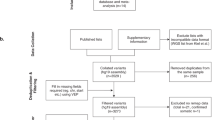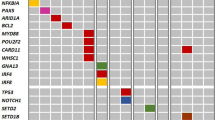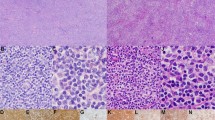Abstract
To characterise the genetics of splenic marginal zone lymphoma (SMZL), we performed whole exome sequencing of 16 cases and identified novel recurrent inactivating mutations in Kruppel-like factor 2 (KLF2), a gene whose deficiency was previously shown to cause splenic marginal zone hyperplasia in mice. KLF2 mutation was found in 40 (42%) of 96 SMZLs, but rarely in other B-cell lymphomas. The majority of KLF2 mutations were frameshift indels or nonsense changes, with missense mutations clustered in the C-terminal zinc finger domains. Functional assays showed that these mutations inactivated the ability of KLF2 to suppress NF-κB activation by TLR, BCR, BAFFR and TNFR signalling. Further extensive investigations revealed common and distinct genetic changes between SMZL with and without KLF2 mutation. IGHV1-2 rearrangement and 7q deletion were primarily seen in SMZL with KLF2 mutation, while MYD88 and TP53 mutations were nearly exclusively found in those without KLF2 mutation. NOTCH2, TRAF3, TNFAIP3 and CARD11 mutations were observed in SMZL both with and without KLF2 mutation. Taken together, KLF2 mutation is the most common genetic change in SMZL and identifies a subset with a distinct genotype characterised by multi-genetic changes. These different genetic changes may deregulate various signalling pathways and generate cooperative oncogenic properties, thereby contributing to lymphomagenesis.
This is a preview of subscription content, access via your institution
Access options
Subscribe to this journal
Receive 12 print issues and online access
$259.00 per year
only $21.58 per issue
Buy this article
- Purchase on Springer Link
- Instant access to full article PDF
Prices may be subject to local taxes which are calculated during checkout





Similar content being viewed by others
References
Isaacson PG, Piris MA, Berger F, Swerdlow SH, Thieblemont C, Pittaluga S et al. Splenic B-cell marginal zone lymphoma. In: Swerdlow SH, Campo E, Harris NL, Jaffe ES, Pileri SA, Stein H, Thiele J, Vardiman JW (eds). WHO Classification of Tumous of Haematopoietic and Lymphoid Tissues. International Agency for Research on Cancer: Lyon, 185–187 2008.
Arcaini L, Lazzarino M, Colombo N, Burcheri S, Boveri E, Paulli M et al. Splenic marginal zone lymphoma: a prognostic model for clinical use. Blood 2006; 107: 4643–4649.
Montalban C, Abraira V, Arcaini L, Domingo-Domenech E, Guisado-Vasco P, Iannito E et al. Risk stratification for splenic marginal zone lymphoma based on haemoglobin concentration, platelet count, high lactate dehydrogenase level and extrahilar lymphadenopathy: development and validation on 593 cases. Br J Haematol 2012; 159: 164–171.
Olszewski AJ, Castillo JJ . Survival of patients with marginal zone lymphoma: analysis of the surveillance, epidemiology, and end results database. Cancer 2013; 119: 629–638.
Arcaini L, Bruno R . Hepatitis C virus infection and antiviral treatment in marginal zone lymphomas. Curr Clin Pharmacol 2010; 5: 74–81.
Zibellini S, Capello D, Forconi F, Marcatili P, Rossi D, Rattotti S et al. Stereotyped patterns of B-cell receptor in splenic marginal zone lymphoma. Haematologica 2010; 95: 1792–1796.
Bikos V, Darzentas N, Hadzidimitriou A, Davis Z, Hockley S, Traverse-Glehen A et al. Over 30% of patients with splenic marginal zone lymphoma express the same immunoglobulin heavy variable gene: ontogenetic implications. Leukemia 2012; 26: 1638–1646.
Mateo M, Mollejo M, Villuendas R, Algara P, Sanchez-Beato M, Martinez P et al. 7q31-32 allelic loss is a frequent finding in splenic marginal zone lymphoma. Am J Pathol 1999; 154: 1583–1589.
Gruszka-Westwood AM, Hamoudi R, Osborne L, Matutes E, Catovsky D . Deletion mapping on the long arm of chromosome 7 in splenic lymphoma with villous lymphocytes. Genes Chromosomes Cancer 2003; 36: 57–69.
Watkins AJ, Huang Y, Ye H, Chanudet E, Johnson N, Hamoudi R et al. Splenic marginal zone lymphoma: characterization of 7q deletion and its value in diagnosis. J Pathol 2010; 220: 461–474.
Watkins AJ, Hamoudi RA, Zeng N, Yan Q, Huang Y, Liu H et al. An integrated genomic and expression analysis of 7q deletion in splenic marginal zone lymphoma. PLoS One 2012; 7: e44997.
Fresquet V, Robles EF, Parker A, Martinez-Useros J, Mena M, Malumbres R et al. High-throughput sequencing analysis of the chromosome 7q32 deletion reveals IRF5 as a potential tumour suppressor in splenic marginal-zone lymphoma. Br J Haematol 2012; 158: 712–726.
Rossi D, Trifonov V, Fangazio M, Bruscaggin A, Rasi S, Spina V et al. The coding genome of splenic marginal zone lymphoma: activation of NOTCH2 and other pathways regulating marginal zone development. J Exp Med 2012; 209: 1537–1551.
Kiel MJ, Velusamy T, Betz BL, Zhao L, Weigelin HG, Chiang MY et al. Whole-genome sequencing identifies recurrent somatic NOTCH2 mutations in splenic marginal zone lymphoma. J Exp Med 2012; 209: 1553–1565.
Martinez N, Almaraz C, Vaque JP, Varela I, Derdak S, Beltran S et al. Whole-exome sequencing in splenic marginal zone lymphoma reveals mutations in genes involved in marginal zone differentiation. Leukemia 2014; 28: 1334–1340.
Parry M, Rose-Zerilli MJ, Gibson J, Ennis S, Walewska R, Forster J et al. Whole exome sequencing identifies novel recurrently mutated genes in patients with splenic marginal zone lymphoma. PLoS One 2013; 8: e83244.
Yan Q, Huang Y, Watkins AJ, Kocialkowski S, Zeng N, Hamoudi RA et al. BCR and TLR signaling pathways are recurrently targeted by genetic changes in splenic marginal zone lymphomas. Haematologica 2012; 97: 595–598.
Rossi D, Deaglio S, Dominguez-Sola D, Rasi S, Vaisitti T, Agostinelli C et al. Alteration of BIRC3 and multiple other NF-{kappa}B pathway genes in splenic marginal zone lymphoma. Blood 2011; 118: 4930–4934.
Liu H, Bench AJ, Bacon CM, Payne K, Huang Y, Scott MA et al. A practical strategy for the routine use of BIOMED-2 PCR assays for detection of B- and T-cell clonality in diagnostic haematopathology. Br J Haematol 2007; 138: 31–43.
Papaemmanuil E, Cazzola M, Boultwood J, Malcovati L, Vyas P, Bowen D et al. Somatic SF3B1 mutation in myelodysplasia with ring sideroblasts. N Engl J Med 2011; 365: 1384–1395.
Varela I, Tarpey P, Raine K, Huang D, Ong CK, Stephens P et al. Exome sequencing identifies frequent mutation of the SWI/SNF complex gene PBRM1 in renal carcinoma. Nature 2011; 469: 539–542.
Stephens PJ, Tarpey PS, Davies H, Van Loo P, Greenman C, Wedge DC et al. The landscape of cancer genes and mutational processes in breast cancer. Nature 2012; 486: 400–404.
Ye K, Schulz MH, Long Q, Apweiler R, Ning Z . Pindel: a pattern growth approach to detect break points of large deletions and medium sized insertions from paired-end short reads. Bioinformatics 2009; 25: 2865–2871.
Bi Y, Zeng N, Chanudet E, Huang Y, Hamoudi RA, Liu H et al. A20 inactivation in ocular adnexal MALT lymphoma. Haematologica 2012; 97: 926–930.
Yan Q, Wang M, Moody S, Xue X, Huang Y, Bi Y et al. Distinct involvement of NF-kappaB regulators by somatic mutation in ocular adnexal malt lymphoma. Br J Haematol 2013; 160: 851–854.
van Dongen JJ, Langerak AW, Bruggemann M, Evans PA, Hummel M, Lavender FL et al. Design and standardization of PCR primers and protocols for detection of clonal immunoglobulin and T-cell receptor gene recombinations in suspect lymphoproliferations: report of the BIOMED-2 Concerted Action BMH4-CT98-3936. Leukemia 2003; 17: 2257–2317.
Hoek KL, Gordy LE, Collins PL, Parekh VV, Aune TM, Joyce S et al. Follicular B cell trafficking within the spleen actively restricts humoral immune responses. Immunity 2010; 33: 254–265.
Winkelmann R, Sandrock L, Porstner M, Roth E, Mathews M, Hobeika E et al. B cell homeostasis and plasma cell homing controlled by Kruppel-like factor 2. Proc Natl Acad Sci USA 2011; 108: 710–715.
Hart GT, Wang X, Hogquist KA, Jameson SC . Kruppel-like factor 2 (KLF2) regulates B-cell reactivity, subset differentiation, and trafficking molecule expression. Proc Natl Acad Sci USA 2011; 108: 716–721.
Adzhubei IA, Schmidt S, Peshkin L, Ramensky VE, Gerasimova A, Bork P et al. A method and server for predicting damaging missense mutations. Nat Methods 2010; 7: 248–249.
Das H, Kumar A, Lin Z, Patino WD, Hwang PM, Feinberg MW et al. Kruppel-like factor 2 (KLF2) regulates proinflammatory activation of monocytes. Proc Natl Acad Sci USA 2006; 103: 6653–6658.
Lenz G, Davis RE, Ngo VN, Lam L, George TC, Wright GW et al. Oncogenic CARD11 mutations in human diffuse large B cell lymphoma. Science 2008; 319: 1676–1679.
Dong G, Chanudet E, Zeng N, Appert A, Chen YW, Au WY et al. A20, ABIN-1/2 and CARD11 mutations and their prognostic value in gastrointestinal diffuse large B-cell lymphoma. Clin Cancer Res 2011; 17: 1440–1451.
Du MQ, Peng H, Liu H, Hamoudi RA, Diss TC, Willis TG et al. BCL10 gene mutation in lymphoma. Blood 2000; 95: 3885–3890.
Mahabeleshwar GH, Kawanami D, Sharma N, Takami Y, Zhou G, Shi H et al. The myeloid transcription factor KLF2 regulates the host response to polymicrobial infection and endotoxic shock. Immunity 2011; 34: 715–728.
Heo KS, Chang E, Takei Y, Le NT, Woo CH, Sullivan MA et al. Phosphorylation of protein inhibitor of activated STAT1 (PIAS1) by MAPK-activated protein kinase-2 inhibits endothelial inflammation via increasing both PIAS1 transrepression and SUMO E3 ligase activity. Arterioscler Thromb Vasc Biol 2013; 33: 321–329.
Zahlten J, Steinicke R, Opitz B, Eitel J, N'guessan PD, Vinzing M et al. TLR2- and nucleotide-binding oligomerization domain 2-dependent Krüppel-like factor 2 expression down-regulates NF-kappa B-related gene expression. J Immunol 2010; 185: 597–604.
Nayak L, Goduni L, Takami Y, Sharma N, Kapil P, Jain MK et al. Kruppel-like factor 2 is a transcriptional regulator of chronic and acute inflammation. Am J Pathol 2013; 182: 1696–1704.
Pillai S, Cariappa A . The follicular versus marginal zone B lymphocyte cell fate decision. Nat Rev Immunol 2009; 9: 767–777.
Cerutti A, Cols M, Puga I . Marginal zone B cells: virtues of innate-like antibody-producing lymphocytes. Nat Rev Immunol 2013; 13: 118–132.
Sun SC . The noncanonical NF-kappaB pathway. Immunol Rev 2012; 246: 125–140.
Niemann CU, Wiestner A . B-cell receptor signaling as a driver of lymphoma development and evolution. Semin Cancer Biol 2013; 23: 410–421.
Catrysse L, Vereecke L, Beyaert R, Van Loo G . A20 in inflammation and autoimmunity. Trends Immunol 2014; 35: 22–31.
Tanigaki K, Han H, Yamamoto N, Tashiro K, Ikegawa M, Kuroda K et al. Notch-RBP-J signaling is involved in cell fate determination of marginal zone B cells. Nat Immunol 2002; 3: 443–450.
Saito T, Chiba S, Ichikawa M, Kunisato A, Asai T, Shimizu K et al. Notch2 is preferentially expressed in mature B cells and indispensable for marginal zone B lineage development. Immunity 2003; 18: 675–685.
Hampel F, Ehrenberg S, Hojer C, Draeseke A, Marschall-Schroter G, Kuhn R et al. CD19-independent instruction of murine marginal zone B-cell development by constitutive Notch2 signaling. Blood 2011; 118: 6321–6331.
Simonetti G, Carette A, Silva K, Wang H, De Silva NS, Heise N et al. IRF4 controls the positioning of mature B cells in the lymphoid microenvironments by regulating NOTCH2 expression and activity. J Exp Med 2013; 210: 2887–2902.
Guo F, Weih D, Meier E, Weih F . Constitutive alternative NF-kappaB signaling promotes marginal zone B-cell development but disrupts the marginal sinus and induces HEV-like structures in the spleen. Blood 2007; 110: 2381–2389.
Magri G, Miyajima M, Bascones S, Mortha A, Puga I, Cassis L et al. Innate lymphoid cells integrate stromal and immunological signals to enhance antibody production by splenic marginal zone B cells. Nat Immunol 2014; 15: 354–364.
Ngo VN, Young RM, Schmitz R, Jhavar S, Xiao W, Lim KH et al. Oncogenically active MYD88 mutations in human lymphoma. Nature 2011; 470: 115–119.
Gruszka-Westwood AM, Hamoudi RA, Matutes E, Tuset E, Catovsky D . p53 abnormalities in splenic lymphoma with villous lymphocytes. Blood 2001; 97: 3552–3558.
Salido M, Baro C, Oscier D, Stamatopoulos K, Dierlamm J, Matutes E et al. Cytogenetic aberrations and their prognostic value in a series of 330 splenic marginal zone B-cell lymphomas: a multicenter study of the Splenic B-Cell Lymphoma Group. Blood 2010; 116: 1479–1488.
Acknowledgements
We would like to thank David Withers for his help in DNA sequencing, and Dr Yuanxue Huang, Howard Martin, Antje Schulze Selting and Robbie Zhao for technical assistance. We would also like to thank NIHR Cambridge Comprehensive Biomedical Research Centre Tissue and Blood Biobank for providing some of the lymphoma samples used in this study. This research was supported by grants from Leukaemia and Lymphoma Research, UK, Addenbrooke’s Charitable Trust. SM is a PhD student supported by MRC and Department of Pathology, University of Cambridge. LEI is a PhD student supported by the Pathological Society of UK and Ireland. NB is a fellow of the European Hematology Association and was supported by a starter grant from the Academy of Medical Sciences.
Author Contributions
AC, MW, SM, LE-I, EM, HL, EFR, GV, JAM-C and DO contributed to data collection and analysis; AC, NB, CG, GG, KB and XX contributed to sequence analysis; LdL, MA-K, AW, GV, AB, MS, GF, JAM-C and DO helped in case contribution; M-QD, AC and MW contributed to manuscript writing and preparation; M-QD and AJW contributed to study design and coordination. All authors commented on the manuscript and approve its submission for publication.
Author information
Authors and Affiliations
Corresponding author
Ethics declarations
Competing interests
The authors declare no conflict of interest.
Additional information
Supplementary Information accompanies this paper on the Leukemia website
Supplementary information
Rights and permissions
About this article
Cite this article
Clipson, A., Wang, M., de Leval, L. et al. KLF2 mutation is the most frequent somatic change in splenic marginal zone lymphoma and identifies a subset with distinct genotype. Leukemia 29, 1177–1185 (2015). https://doi.org/10.1038/leu.2014.330
Received:
Revised:
Accepted:
Published:
Issue Date:
DOI: https://doi.org/10.1038/leu.2014.330
This article is cited by
-
A comparison of the International Consensus and 5th World Health Organization classifications of mature B-cell lymphomas
Leukemia (2023)
-
The many faces of nodal and splenic marginal zone lymphomas. A report of the 2022 EA4HP/SH lymphoma workshop
Virchows Archiv (2023)
-
Mutational landscape of marginal zone B-cell lymphomas of various origin: organotypic alterations and diagnostic potential for assignment of organ origin
Virchows Archiv (2022)
-
Deciphering the genetic landscape of pulmonary lymphomas
Modern Pathology (2021)
-
Thyroid MALT lymphoma: self-harm to gain potential T-cell help
Leukemia (2021)



